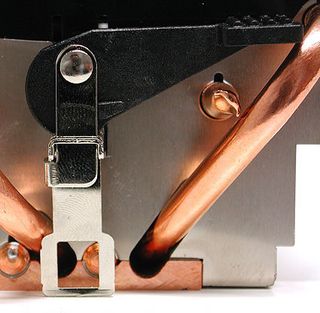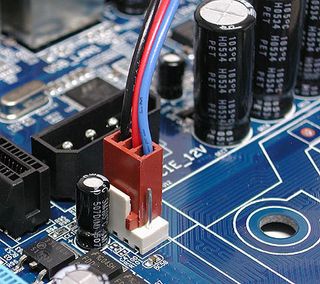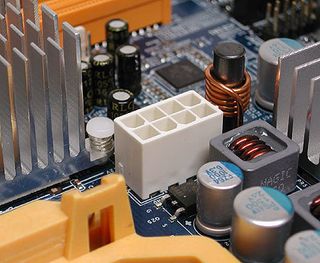AM2: AMD Reinvents Itself
Heatsinks: Things Gets Louder, Continued
The new model is still held in place by two clips, which are hung on the lugs on the retention module. AMD has also improved the safety catch: it has been completely overhauled, and can no longer break off as often happened with the old heatsinks.

Securing the heatsink on Socket AM2: finally, no more breakage!

There are quite a few of these safety catches lying around broken at the THG lab in Munich.
The new AM2 heatsink from AVC weighs 445 grams, making it lighter than the old Socket 939 heatsink (486 grams).
What's annoying is the far greater noise levels coming from the small fan, which slowly but surely is starting to match the volume produced by the Intel boxed heatsink. If a case is badly ventilated it soon starts roaring so loudly that it is impossible to concentrate on work; this wasn't an issue with the old heatsink. We recommend buying an after-market heatsink.
As with the Intel models, AMD now also features the four-pole plug for connecting the heatsink. This means that AMD boards now also offer much more precise fan control based on pulse width modulation (PWM). However, the boxed heatsink delivered by AMD still doesn't have a matching plug, leaving users without this function, at least for the time being.

The socket already uses the four-pole design, but the heatsink is still not up to the latest standards.
Stay on the Cutting Edge
Join the experts who read Tom's Hardware for the inside track on enthusiast PC tech news — and have for over 25 years. We'll send breaking news and in-depth reviews of CPUs, GPUs, AI, maker hardware and more straight to your inbox.
Despite the almost identical dissipation levels of the top CPUs, AMD still uses the four-pole plug for the CPU power supply.

At CPU performances of up to 125 W, some manufacturers - in this case Biostar - now use 8 pins.
Current page: Heatsinks: Things Gets Louder, Continued
Prev Page New Energy-efficient Processors Next Page Features: Virtualization And TCPATom's Hardware's dedicated news crew consists of both freelancers and staff with decades of experience reporting on the latest developments in CPUs, GPUs, super computing, Raspberry Pis and more.

